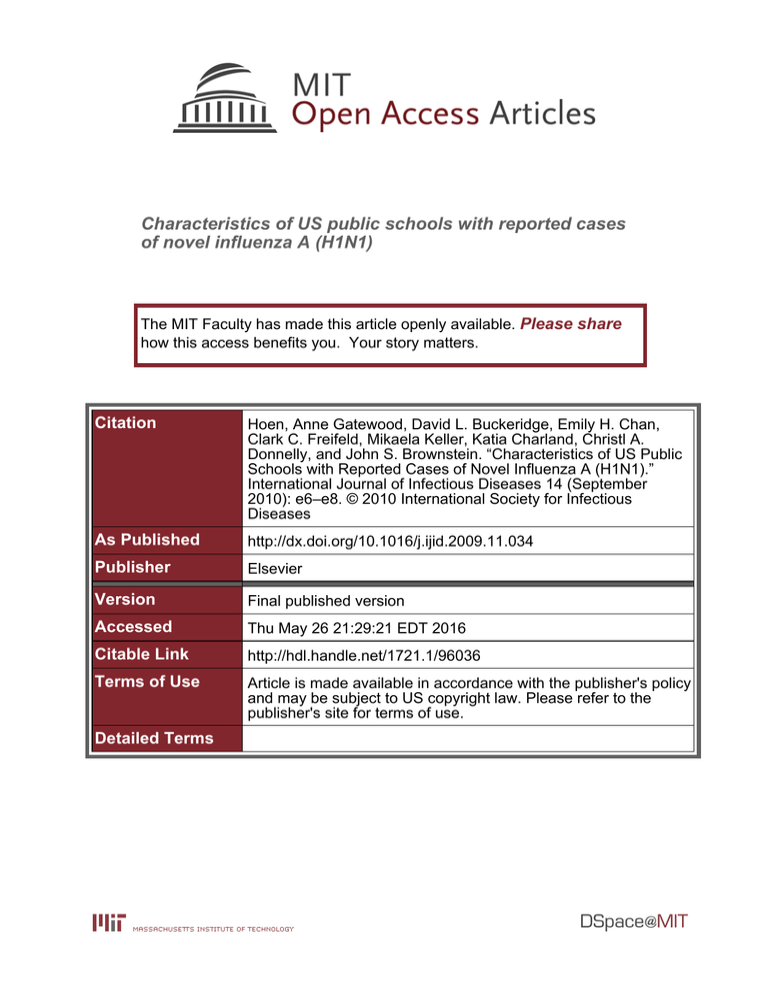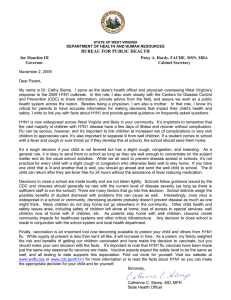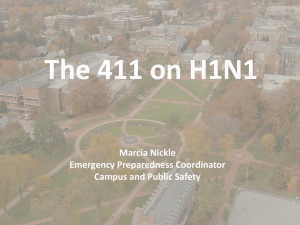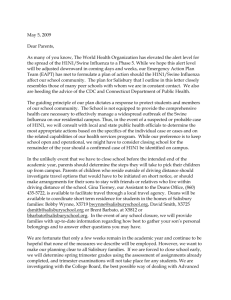
Characteristics of US public schools with reported cases
of novel influenza A (H1N1)
The MIT Faculty has made this article openly available. Please share
how this access benefits you. Your story matters.
Citation
Hoen, Anne Gatewood, David L. Buckeridge, Emily H. Chan,
Clark C. Freifeld, Mikaela Keller, Katia Charland, Christl A.
Donnelly, and John S. Brownstein. “Characteristics of US Public
Schools with Reported Cases of Novel Influenza A (H1N1).”
International Journal of Infectious Diseases 14 (September
2010): e6–e8. © 2010 International Society for Infectious
Diseases
As Published
http://dx.doi.org/10.1016/j.ijid.2009.11.034
Publisher
Elsevier
Version
Final published version
Accessed
Thu May 26 21:29:21 EDT 2016
Citable Link
http://hdl.handle.net/1721.1/96036
Terms of Use
Article is made available in accordance with the publisher's policy
and may be subject to US copyright law. Please refer to the
publisher's site for terms of use.
Detailed Terms
International Journal of Infectious Diseases 14S (2010) e6–e8
Contents lists available at ScienceDirect
International Journal of Infectious Diseases
journal homepage: www.elsevier.com/locate/ijid
Perspective
Characteristics of US public schools with reported cases of novel
influenza A (H1N1)
Anne Gatewood Hoen a,b,c, David L. Buckeridge c,d, Emily H. Chan a, Clark C. Freifeld a,e,
Mikaela Keller a,b, Katia Charland a,b,c, Christl A. Donnelly f, John S. Brownstein a,b,*
a
Children’s Hospital Informatics Program, Harvard-MIT Division of Health Sciences and Technology, Boston, Massachusetts, USA
Department of Pediatrics, Harvard Medical School, Boston, Massachusetts, USA
Department of Epidemiology, Biostatistics and Occupational Health, McGill University, Montreal, Quebec, Canada
d
Direction de santé publique de Montréal, Québec, Canada
e
MIT Media Laboratory, Massachusetts Institute of Technology, Cambridge, Massachusetts, USA
f
MRC Centre for Outbreak Analysis and Modelling, Department of Infectious Disease Epidemiology, Faculty of Medicine, Imperial College London, London, UK
b
c
A R T I C L E I N F O
S U M M A R Y
Article history:
Received 15 October 2009
Accepted 26 November 2009
Objective: The 2009 pandemic of influenza A (H1N1) has disproportionately affected children and young
adults, resulting in attention by public health officials and the news media on schools as important
settings for disease transmission and spread. We aimed to characterize US schools affected by novel
influenza A (H1N1) relative to other schools in the same communities.
Methods: A database of US school-related cases was obtained by electronic news media monitoring for
early reports of novel H1N1 influenza between April 23 and June 8, 2009. We performed a matched case–
control study of 32 public primary and secondary schools that had one or more confirmed cases of H1N1
influenza and 6815 control schools located in the same 23 counties as case schools.
Results: Compared with controls from the same county, schools with reports of confirmed cases of H1N1
influenza were less likely to have a high proportion of economically disadvantaged students (adjusted
odds ratio (aOR) 0.385; 95% confidence interval (CI) 0.166–0.894) and less likely to have older students
(aOR 0.792; 95% CI 0.670–0.938).
Conclusions: We conclude that public schools with younger, more affluent students may be considered
sentinels of the epidemic and may have played a role in its initial spread.
ß 2010 International Society for Infectious Diseases. Published by Elsevier Ltd. All rights reserved.
Corresponding Editor: William Cameron,
Ottawa, Canada
Keywords:
Influenza A (H1N1)
HealthMap
Schools
Age
Socioeconomic status
1. Introduction
One striking feature of the 2009 pandemic of novel influenza A
(H1N1) has been the skewed age distribution of confirmed cases,
with children and young adults disproportionately affected.1 Early
clinical evidence revealed a shift in the age distribution, with the
majority of deaths and severe cases being patients between the
ages of 5 and 59 years, and especially children.2–4 Possible
explanations for this pattern of infection include preexisting
immunity in older age groups and an important role for schools as
settings for the early outbreaks of the pandemic.1,5
We monitored in real-time the early school-related outbreaks
of novel H1N1 influenza in the USA using the event-based
HealthMap disease surveillance platform.6–8 HealthMap monitors
informal web-based media reports, moderated distribution lists
such as ProMED Mail, and official public health agency alerts for
* Corresponding author. Tel.: +1 617 355 6998; fax: +1 617 730 0267.
E-mail address: john.brownstein@childrens.harvard.edu (J.S. Brownstein).
disease outbreak information. We analyzed early media reports
collected by HealthMap for information on novel H1N1 influenza
outbreaks in schools in order to build an early epidemiological
picture of the novel H1N1 epidemic in US public schools.9
2. Methods
Between April 23 and June 8, 2009, HealthMap detected 181
English-language media reports related to suspected or confirmed
cases of novel H1N1 influenza in schools and universities
worldwide. We filtered these reports to examine more closely
public primary and secondary schools in the USA with one or more
confirmed cases of novel H1N1 influenza, resulting in 49 reports
referring to 32 individual schools in 23 US counties (Figure 1).
We were interested in identifying characteristics of schools
impacted by H1N1 influenza. Using data from the National Center
for Education Statistics (NCES), we examined the features of US
public primary and secondary schools with confirmed cases
relative to other schools in the same communities. Data were
obtained from the NCES for each of the schools with a media report
1201-9712/$36.00 – see front matter ß 2010 International Society for Infectious Diseases. Published by Elsevier Ltd. All rights reserved.
doi:10.1016/j.ijid.2009.11.034
A.G. Hoen et al. / International Journal of Infectious Diseases 14S (2010) e6–e8
e7
We used a backward elimination model selection procedure
to build a multivariate model to estimate the probability of a
school having one or more confirmed cases detected by
HealthMap. The number of students enrolled in the school was
log-transformed and included in all models to account for the
probability of one or more confirmed cases as a function of
student body size. Because schools with media reports were
matched to control schools within the same county, we used
conditional logistic regression to account for within-county
dependence. The R Statistical System (version 2.7.2, R Foundation
for Statistical Computing, http://www.R-project.org) was used
for all statistical computations.
3. Results
Figure 1. Map of counties showing schools with one or more confirmed cases of
H1N1 influenza detected by HealthMap.
of novel H1N1 cases, as well as for all of the other schools in the
counties in which the schools in our dataset were located. The
resulting database included 32 schools with one or more media
reports detected by HealthMap and 6815 nearby control schools
with no media reports detected by HealthMap. By comparing
schools with confirmed cases to other schools in the same
communities, we aimed to avoid sampling bias due to inconsistent
media coverage across communities as well as confounding due to
geography.
We examined relationships between the probability of one or
more confirmed cases of novel H1N1 influenza and several
characteristics of schools: highest and lowest grade levels at the
school, indicating the age groups present at the school; grade span,
or number of grades at the school; student-to-teacher ratio;
whether or not the school qualifies for funding under Title 1, a
program that provides federal assistance to schools to support
economically disadvantaged students, a socioeconomic indicator;
whether or not the school is located within an ‘urbanized area’ as
defined by the US Census Bureau;10 the proportion of students
belonging to four racial/ethnic groups: Hispanic, white, black and
Asian; and racial/ethnic diversity, measured using Simpson’s index
of diversity, D,11 which was calculated using the following
formula:
P
nðn 1Þ
;
D¼1
NðN 1Þ
where N is the total number of students in the school and n is the
number of students of each racial/ethnic group in the school.
Relationships between school characteristics and media reports
of H1N1 are presented in Table 1. The final multivariate model
revealed independent significant relationships with number of
students (adjusted odds ratio (aOR) 7.344, 95% confidence interval
(CI) 3.100–17.398; p < 0.001), highest grade level (aOR 0.792, 95%
CI 0.670–0.938; p = 0.007), and Title 1 status (aOR 0.385, 95% CI
0.166–0.894; p = 0.025). As expected, schools with more students
were more likely to have been reported as having one or more
confirmed cases of novel H1N1 influenza. In addition, schools with
lower maximum grade levels (in general, primary schools) and
schools not qualifying for Title 1 funding (schools with fewer
economically disadvantaged students) were more likely than other
schools in the same county to have been detected. Lowest grade
level, grade span, student-to-teacher ratio, the urbanized areaindicator, and the variables relating to racial/ethnic makeup of
schools were dropped from the final multivariate model. Overall,
this analysis suggests that within affected counties, affluent
schools with a younger student body are more likely than other
schools in the same community to have confirmed cases of novel
H1N1 influenza that are picked up by the media and detected by
HealthMap.
4. Discussion
We have presented an initial characterization of the US public
schools affected by the recent novel H1N1 influenza outbreak
using a real-time, informal surveillance system, HealthMap. While
there is no tool for monitoring outbreaks of this nature in the US
that is without detection biases, there are some limitations specific
to our approach. Namely, we were limited not only by the ability of
public health officials to detect and confirm cases, but also by the
Table 1
School characteristics and conditional logistic regression models.
Univariate/bivariate models*
Mean SD or n (%)
Final multivariate model
Variable
Schools with one
or more cases (n = 32)
Other schools in
county (n = 6815)
OR (95% CI)
p-Value
aOR (95% CI)
p-Value
Student body size
Lowest grade at school
Highest grade at school
Grade span
Student–teacher ratio
Title 1 school (%)
Located in urbanized area (%)
Proportion Hispanic students
Proportion white students
Proportion black students
Proportion Asian students
Racial/ethnic diversity
945.22 677.21
3.38 4.19
7.53 3.20
4.16 2.38
16.08 3.45
14 (43.8)
24 (75.0)
0.13 0.21
0.55 0.35
0.09 0.19
0.23 0.32
0.32 0.20
704.10 618.54
2.42 3.81
7.16 2.93
4.74 2.33
17.28 4.98
4694 (68.9)
6311 (92.6)
0.37 0.32
0.31 0.32
0.19 0.27
0.12 0.18
0.40 0.21
3.759
0.929
0.828
0.961
0.991
0.525
1.697
0.180
4.611
0.154
0.939
0.450
<0.001
0.185
0.024
0.671
0.893
0.118
0.519
0.199
0.133
0.211
0.533
0.546
7.344 (3.100, 17.398)
–
0.792 (0.670, 0.938)
–
–
0.385 (0.166, 0.894)
–
–
–
–
–
–
<0.001
–
0.007
–
–
0.025
–
–
–
–
–
–
(2.158, 6.547)
(0.832, 1.036)
(0.703, 0.975)
(0.881, 1.153)
(0.872, 1.126)
(0.234, 1.178)
(0.340, 8.463)
(0.013, 2.467)
(0.627, 33.894)
(0.008, 2.897)
(0.042, 21.204)
(0.033, 6.000)
SD, standard deviation; OR, odds ratio; aOR, adjusted odds ratio; CI, confidence interval.
*
Student body size model is univariate. All others are bivariate, with log-transformed student body size as the unlisted explanatory variable.
e8
A.G. Hoen et al. / International Journal of Infectious Diseases 14S (2010) e6–e8
ability and willingness of the media to report them. This was less of
an issue in the early stages of the epidemic, when both sectors were
actively investigating outbreaks, and for this reason we limited our
analysis to the earliest news reports. Detailed evaluation of the
utility of these data sources remains an important research
question. However, our approach allowed us to quickly detect and
catalog, in real-time, outbreaks of novel H1N1 influenza in schools
that, to our knowledge, were not otherwise formally documented
at this scale. Influenza transmission in schools is not reportable to
the state or federal governments, making the news media a
potentially more sensitive and timely data source then the current
voluntary systems in place.
We compared schools that were reported to have experienced
outbreaks of novel H1N1 influenza with nearby schools that
were not, and we have presented an initial investigation of
school characteristics associated with such reporting. Our
observation that schools with lower grade levels were likely
to have an early case report detected by HealthMap is consistent
with previous reports implicating the younger pediatric age
groups as early sentinels of seasonal influenza epidemics.12
However, it is not entirely clear why more affluent schools with
lower grade levels were more likely than other schools in the
same county to report cases. Given the relatively mild clinical
outcomes of the first cases, it could be that students attending
these schools were more likely than others to have their illness
diagnosed by a physician and thus reported as confirmed cases,
or that these schools were more likely to receive media coverage
when a case was detected. Because many of the first schoolrelated cases of the epidemic were the result of students with
travel histories to Mexico, it is also possible that these schools
were more likely to have students who had recently traveled to
Mexico. It is unclear whether the characteristics of schools
identified represent actual risk factors for infection, or whether
they characterize schools that may be most sensitive to case
detection and media reporting. Nonetheless, the novel influenza
A (H1N1) influenza pandemic has illustrated the importance of
understanding the best targets for surveillance efforts to allow
for early, sensitive, and accurate outbreak detection. Informal,
event-based disease surveillance tools such as HealthMap and
others hold promise as useful technologies that enable real-time
assessments of epidemiological characteristics prior to the
availability of such information through more traditional
surveillance methods.
Acknowledgements
We gratefully acknowledge Amy Sonricker, Susan Aman,
Rebecca F. Baggaley, and T. Déirdre Hollingsworth for helpful
discussions and computational support.
Funding support: This work was supported by R21AI073591-01
from the National Institute of Allergy and Infectious Diseases,
National Institutes of Health, PAN-83152 and CAT-86857 from the
Canadian Institutes of Health Research, and a research grant from
Google.org. CAD acknowledges the Medical Research Council, UK,
for funding support. Neither the funding sources nor the sponsor
played a role in the design and conduct of the study; the collection,
management, analysis, and the interpretation of the data; or in the
preparation, review, and approval of the manuscript.
Conflict of interest: The authors have no conflicts of interest to
report.
References
1. Peiris JS, Poon LL, Guan Y. Emergence of a novel swine-origin influenza A virus
(S-OIV) H1N1 virus in humans. J Clin Virol 2009;45:169–73.
2. Chowell G, Bertozzi SM, Colchero MA, Lopez-Gatell H, Alpuche-Aranda C,
Hernandez M, et al. Severe respiratory disease concurrent with the circulation
of H1N1 influenza. N Engl J Med 2009;361:674–9.
3. Fraser C, Donnelly CA, Cauchemez S, Hanage WP, Van Kerkhove MD, Hollingsworth TD, et al. Pandemic potential of a strain of influenza A (H1N1): early
findings. Science 2009;324:1557–61.
4. Nishiura H, Castillo-Chavez C, Safan M, Chowell G. Transmission potential of the
new influenza A (H1N1) virus and its age-specificity in Japan. Euro Surveill
2009;14(pii):19227.
5. World Health Organization. Preliminary information important for understanding the evolving situation: pandemic (H1N1) briefing note 4. Geneva: World
Health Organization; 2009.
6. Brownstein JS, Freifeld CC, Reis BY, Mandl KD. Surveillance Sans Frontieres:
Internet-based emerging infectious disease intelligence and the HealthMap
project. PLoS Medicine 2008;5:E151.
7. Brownstein JS, Freifeld CC, Madoff LC, Influenza A. (H1N1) virus, 2009—online
monitoring. N Engl J Med 2009;360:2156.
8. Freifeld CC, Mandl KD, Reis BY, Brownstein JS. HealthMap: global infectious
disease monitoring through automated classification and visualization of Internet media reports. J Am Med Inform Assoc 2008;15:150–7.
9. Keller M, Blench M, Tolentino H, Freifeld CC, Mandl KD, Mawudeku A, et al. Use
of unstructured event-based reports for global infectious disease surveillance.
Emerg Infect Dis 2009;15:689–95.
10. United States Bureau of the Census. Geographic areas reference manual.
Washington, DC: US Department of Commerce, Economics and Statistics Administration, Bureau of the Census; 1994.
11. Simpson EH. Measurement of diversity. Nature 1949;163:1.
12. Brownstein JS, Kleinman KP, Mandl KD. Identifying pediatric age groups for
influenza vaccination using a real-time regional surveillance system. Am J
Epidemiol 2005;162:686–93.





